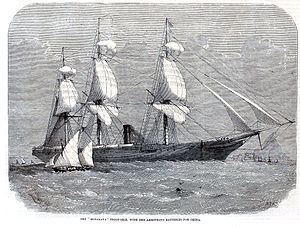Class and type Passenger ship Laid down 1852 Renamed C60 in December 1895 Launched 24 May 1853 Weight 4,765 tons Tons burthen 3.223 million kg | Name HMS Himalaya Acquired July 1854 Construction started 1852 Length 104 m Displacement 4.255 million kg | |
 | ||
Reclassified Coal hulk, December 1895 Builder Thames Ironworks and Shipbuilding Company | ||
HMS Himalaya was ordered by the Peninsular and Oriental Steam Navigation Company as SS Himalaya, a 3,438 gross register ton iron steam screw passenger ship. When launched in 1853 she was the largest passenger ship in the world until exceeded in size by the completion of RMS Atrato a few months later. She was purchased by the Royal Navy in 1854 for use as a troopship until 1894 and was then moored in Portland Harbour to serve as a Navy coal hulk until 1920, when sold off. She was sunk during a German air attack on Portland Harbour in 1940.
Contents
Design and construction
Himalaya had been planned as a paddle steamer but that design was becoming outdated and she was altered to screw propulsion while she was still on the stocks, and she was fitted instead with a single two-bladed propeller of 18 feet diameter. She was also fitted with sails on three masts for use when the wind was favourable. She was laid down at the yards of C. J. Mare & Co., Leamouth, London in 1852 and launched on 24 May 1853. She could carry 200 first class passengers and required a crew of 213.
Sale and commissioning
She proved to be a larger vessel than the passenger traffic demanded and coal was becoming more expensive with the advent of war in the Crimea in 1854, so P&O were happy to sell her to the British Government at her cost price of £130,000 in July 1854 for use as a troopship. The Royal Navy had built smaller vessels, so called frigates, during the 1840s, such as HMS Simoom, which had served as troopships when the idea of iron warships was discredited by live-firing trials. Himalaya was purchased during the Crimean War when there was a pressing need for troopships. The purchase was viewed with suspicion by naval experts. General Howard Douglas is reported to have predicted that she would have a short career.
Career and sinking
She served as a troopship for almost four decades, supporting operations during the Second Opium War, and carrying troops to India, South Africa, the Gold Coast, and North America. She was retired from trooping service in 1894 and became a coal hulk at Portland Harbour with the new name C60 in December 1895. She was sold out of the navy on 28 September 1920 to a private owner, E. W. Payne, and continued to be based in Portland Harbour, probably still as a coal hulk.
She continued in this role until the Second World War. She was sunk by air attack, by Junkers 87 dive bombers of the German Luftwaffe, on 12 June 1940.
